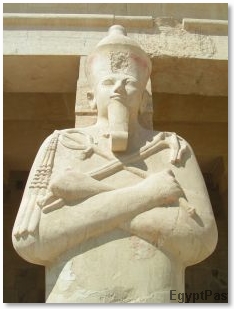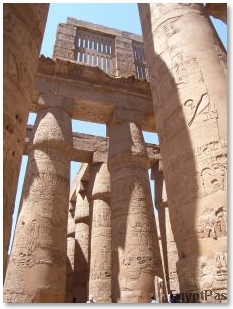History of Ancient Egypt

A Stone AGuardian - Note the Ceremonial Beard (usually a wig), Symbol of Authority
It is difficult to construct a precise outline or chronology of the history of ancient Egypt. Our knowledge of the distant Egyptian past is imperfect due, not only to the passage of time which has erased much evidence, but to the fact that the Egyptians themselves did not care to record their history in any comprehensive way. There is no national history among the surviving papyrus documents.
To compund the problems of reconstructing the history of this people, the Egyptians (like many ancient peoples) did not count their years from a single date going forward. Time was reckoned in the years of the reigning sovereign, and with each the numbering, began afresh. But even this method is only partially carried out. Annals in the sense in which they were recorded by the Assyrians were never systematically written, so far as extant documents show.
Egyptologists are left with the task of reconstructing the past from those few chronologies that the Egyptians themselves created. However these documents, written on centuries old fragile papyrus are not always intact; and sometimes the information is derived not from a primary source but from quotations in the works of later, non Egyptian writers and historians. For example, the royal papyrus at Turin might have furnished a valuable guide into the timeline of the Egyptian dynasties, but it was shattered beyond repair. The lists of MANETHO (q. v.) are valuable, but they have been preserved in such fragmentary and contradictory shape by Eusebius, Josephus, Africanus, and others, as to have lost much of their usefulness. They furnish, nevertheless, the only practicable way of locating historical events by dynasties. In terms of our era only the latest dates can be fixed accurately: e. g. Necho, 609-595 B. C.; Shishak about 930 B. C.; Ramses II. in the thirteenth century, and Thothmes III. possibly in the fifteenth century B. C. Amenemha I. is variously put at 2130, 2380 and 2466 ; Khufu (Cheops, Suphis) at 2830 (Meyer), 3124 (Lepsius), 3766 (Brugseh); while Menes is put at 4400 (Brugsch), 3892 (Lepsius), 3613 (Unger), 5004 (Mariette), 5867 (Champollion), and 5650 (Wiedemann).
Each of these estimates is as little capable of proof as the others. The immense differences are due to the various theories touching contemporary dynasties, a problem of exceeding diffuculty. It seems probable, however, that Manetho gives in his list only the legitimate rulers, and has passed over in silence those whose claims were ill founded. General.—Of the development of the Egyptian kingdom and of the conditions which preceded the reign of Menes, the first king, the inscriptions tell nothing.

Nit, Goddess of the city Sais
Manetho speaks of gods, demi-gods, and sovereigns from Thinis and Memphis, while the royal papyrus at Turin enumerates beings called "Followers of Horus," as the precursors of Menes. These beings of course were mere myths. It has been claimed that traces of a stone age are found in Egypt, but proof is still lacking, since the remains thus far found can be assigned to historical times. At the opening of their recorded history the Egyptians seem to have possessed of an ancient culture which presupposes a long period of development.

A Ruined Temple
The kingdom of Menes was already organized as fully as that of the later kings, the main difference being only in its extent. The data of the early history of Egypt are mainly isolated facts, statements of the exploits of various kings and private persons. A connected history of native origin does not exist. The Turin papyrus and Manetho are often in contradiction with the monuments. The lists of kings at Abydos (see Memnonium) give only a selection, though the tablet of Seti I. contains 76 names and that of Ramses II. 18 names. The list of Saqqarah comprises 42 names.
It is upon such a basis as this that the framework of Egyptian history and chronology has been formed, supplemented by many inscriptions, which supply an immense amount of bombastic phrase of a laudatory character, combined with a vanishing modicum of historical information. The gaps in the list and the Egyptian habit of glossing over defeat and internal dissension have left us with a very fragmentary notion of the chronology of the people who possessed the most ancient known culture of the world. Old Kingdom.—No inscriptions have survived from the first three dynasties, though the "step-pyramid" of Saqqarah is ascribed to Uenephes (Egypian, Ata), the fourth king of the first dynasty, and some statues of functionaries of the time have been preserved. Of MENES (q. v.), the first king, little is known except that he hailed from This (i. e. Thinis) in Upper Egypt, and founded Memphis.
The lists of kings given by Manetho are fairly confirmed by the monuments of following times. With the fourth dynasty contemporary records begin to appear in the tombs (see MASTABA) and pyramids of Gizeh and Saqqarah, built by Snofru (Manetho, Soars, q. v.), Khufu (Cheops ; Manetho, SUPHIS (q. v.), Chefren (Chafra, Khafra), and Menkara (Mycerinus, q. v.) for themselves and their nobles. From the tombs a knowledge of the life of the times is derived, and in the execution of the scenes depicted there is evidence of a developed artistic sense. The long reigns of these kings were employed in building these and other structures in all parts of the land. An unpublished papyrus at St. Petersburg tells of an invasion of the Delta by Asiatics in the time of Snofru, which led to the building of the fortifications on the isthmus at the avenues of approach. See SHUR.
pyramids Egypt Mummies Search Engines Link Report
Egyptian Cities | Egyptian Education | Ancient Egypt | egyptian clothing | Egyptian Houses | The Egyptians | Egyptian Family Life | Egypt and its Neighbours | Government in Ancient Egypt | Egyptian History | Military | Organization of Ancient Egypt | Recreation | Egyptian Religion | Pyramids | About | Privacy Policy | Site News | Site Map
EgyptPast.com - Facts and Information About the History of Ancient Egypt
-